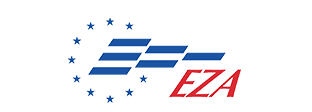From 9 to 10 June 2023 took place in Ružomberok/Slovakia a seminar about “Safe and healthy work in the digital age”, organized by NKOS (Nezávislé krestanské odbory Slovenska), in cooperation with EZA and funded by the European Union. 50 representatives of workers’ organisations from Slovakia, Czech Republic, Poland, Hungary, Belgium, Albania, Austria and Slovenia participated in the seminar.
As part of the project, we dealt with the following problems:
What does digitalization mean for occupational safety and health? How is digitalization shaping our working lives and workers’ safety and health? How can we address the challenges and maximize the opportunities for health and safety at work? What tools for occupational safety and health tools must be created or developed further? What OSH prevention and management policies, practices, strategies, and so on, exist? What is the scope of these policies, practices, strategies, and so on? What risks do these policies and practices address?
The topic is relevant for trade unions. New ways of working, new professions, and new management approaches are a big challenge for us. The 2023-25 Healthy Workplaces campaign raises awareness about the impact of new digital technologies on work and workplaces and the associated occupational safety and health (OSH) challenges and opportunities.
Ľubica Černá presented the new EU-OSHA 2023-25 Healthy Workplaces campaign. The impact of new digital technologies on work and workplaces and the associated occupational safety and health (OSH) challenges and opportunities.
Jakub Meisner, DTP expert Mayer/McCann Erickson, spoke about good experiences with the implementation of digitalization in a cultural institution. In the beautiful premises of the Pribylina open-air museum, he presented us with the possibilities of using digitalization in culture. In his presentation, he talked about working conditions during the scanning of cultural heritage and the organization of work in processing and preserving history for the future.
Katarína Markovičová, director of the University counseling center, presented the possibilities of protection against cyberbullying of employees, students, and children.
Lies Van Rompaey and Babs De Vocht (ACV-CSC) presented the experience from Flanders. Trade unions COV emphasizes that in addition to one-time investments, there is also a need for a long-term vision. Because digitization is not just a matter of infrastructure and hardware. There must also be a solid vision behind it. Digitization offers enormous opportunities in education and we can make full use of them. But we must not be blind to the problems and concerns that digitization brings to the education sector.
Lidmila Nemcová stressed the need for lifelong learning with the support of various European grants and foundations as well as inter-neighbourly and intergenerational cooperation. She stressed the need for an ethical and safe digital environment. She expressed the need to change the methods of teaching ICT to seniors compared to pupils. Last but not least, seniors' motivation and desire to learn something new are also needed.
The Word Cafe activity was very interesting. In small discussion groups, which took turns, we discussed the following questions:
1 How will the labor market change under the influence of digitalization? 2 What challenges does digitalization bring for safety and safety at work? 3 How to protect your health (physical and mental) in a digital environment?
The following aspects were highlighted by the participants in the discussion:
It is indispensable to clarify the definition of working time, when it is available to the employer and when he is off. In addition to proper material provision (ergonomic seating, provision of ICT tools, internet ...), it is also necessary to think about the psychological health of the employees. It is also essential to meet people in person, not to be only in the online space all the time, to think about psycho-hygiene. We need to protect ourselves in the online space, just as we protect ourselves in the physical space.
Aneta Szczykutowics presented the positives and negatives of digitalization. The negative side of digitalization is the mentality of a lone wolf, the overload of working with a lot of information. The goal of work is missing, whereby the computer makes the decisions and the human has to implement them. Increased pressure is put on employees, controlling productivity without human perception, leading to the dehumanization of management. Ms. Aneta recommends that companies should ensure the integration of workers to ensure their recognition and respect by the employer. It is important to cooperate with psychologists who provide counselling,
Monika Drąg focused her presentation on ensuring mental health. Digitalization brings with it many problems and risks, such as isolation of employees, difficult separation of work and personal time, difficulties in administrative regulation, and overload. She offered specific advice on how to mitigate these negatives.
Bardócz András, KPSZT, Hungary, Karolina Korenčan, NSi, Slovenia, Veronika Höfenstock, GÖD, Austria, Marie Čapková, hKaP, Czech Republic, Sali Metani, SAUATT, Albania presented how trade unions in their countries are addressing the challenges of protecting workers in the digital age.
In the next practical block Zdena Černá, physiotherapist and Noemi Šimunková, medical student, presented the possibilities of health protection, what we can do ourselves and what can be required from the employer. Demonstrations of stretching exercises were an enrichment of the seminar, when we moved from the sedentary way of conducting the seminar, to health-beneficial movement. Checking our blood sugar and blood pressure readings showed us how easy it is to know our health status and how we can protect ourselves.
We have identified common recommendations:
It is important to define and understand all the potential sources of hazards in the workplace. Identifying those safety hazards and issues is the first step in protecting employees in the workplace. After identifying all the possible workplace hazards, the next step is to define safety policies and procedures. As some employees are reluctant to share their safety issues with their direct managers, some organizations appoint designated health and safety representatives. Workers must be able to trust that their leaders’ number one priority is keeping their employees safe and that they can report to them if they notice any unsafe activity.
Here are a few tips for trade unions driving employees’ engagement:
- Encourage employees to suggest practical solutions and address their concerns in order to maximize safety.
- Enable and empower employees to get involved in defining workplace policies and speak up about workplace safety issues.
- Ask them for feedback and urge them to report hazards and continuously.
- Continuously emphasize the importance of keeping themselves and their colleagues safe.


